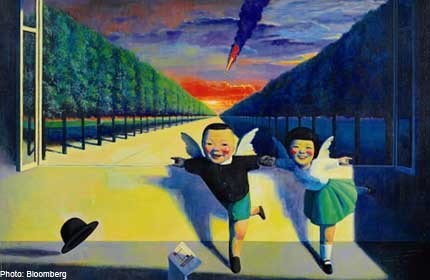Passion investments on the rise

SINGAPORE - Wealthy Asians are showing a growing appetite for alternative investments such as wine and fine art.
These sophisticated investors are increasingly looking at diversifying from traditional investments and are seeking safety and yields from more esoteric investment products, a Knight Frank wealth report shows.
These assets, also known as passion investments, occupy a niche that combines aspects of luxury spending with collecting and investing.
Asian high net worth individuals (HNWIs) increased their allocation for passion investments by 7 per cent last year, according to the report's survey of private bankers and wealth advisers.
This year, it is expected to increase by another 7 per cent, said Knight Frank.
In the report that compiles the attitudes of the wealthy towards alternative investments, Tilburg University associate professor of art finance and alternative investments Rachel Pownall said: "It is their potential as an alternative to traditional asset classes that is raising the profile of collectables."
"Reasons for investing in passion assets can be purely rational. Their performance tends not to fluctuate with that of stocks and bonds, and they can hold their value during periods of expected inflation," added Dr Pownall.
Last year, wine was the most popular investment of passion among HNWIs in Singapore, Hong Kong and China.
Singaporean investors increased their investments in wine by 47 per cent, and are expected to do so by 41 per cent this year, said Knight Frank.
Local wine expert George Wong attributed the popularity of investing in wine over structured investments to its independence from financial markets, portability and the absence of capital gains tax.
Investment-grade wines such as the Grand Cru Classe from Bordeaux have performed impressively, he said. Investors can expect returns of 12 to 15 per cent per annum.
Mr Wong recommended buying investment-grade wines en primeur.
En primeur, or "wine futures", is a method of buying wines early while they are still in barrels. This offers customers the chance to invest in them before they are bottled, and payment is made a year or 18 months before the official release of a vintage.
The wines might be considerably cheaper during the en primeur period.
But it is not always easy to tell which wine would make a good investment, as some wines lose their value over time.
Less than 1 per cent of the world's wines are of investment-grade quality, added Mr Wong.
Meanwhile, collecting fine art is gaining popularity among Singapore-based HNWIs, with private bankers reporting that their clients anticipate spending 43 per cent more on art pieces this year.
One common misconception of investing in art is that only the wealthy can afford to do so.
Anyone with $20,000 or more to spare can also consider investing in art, said Mr Saaed Shah, managing director of Art Futures Group (AFG), an art investment brokerage.
An investor can start his portfolio with that amount at AFG, said Mr Shah. This includes ownership of the painting and full documentation.
As the value of art is not directly related to financial markets, art pieces provide investors with a safe option of diversifying their portfolios.
"Good pieces of art stand the test of time better than many other forms of assets.
"Unlike property, you can transport art around the world with relative ease to find a more favourable market when the going is tough," said Mr Daniel Komala, chief executive officer of Larasati Auctioneers.
The risks associated with investing in art are also relatively low, as long as the paintings are kept in good condition.
Furthermore, income tax is not levied on investing in art.
However, art investment requires a medium- to long-term horizon, and one should be prepared to hold an art piece for at least five years before selling it for a profit, warned Mr Komala.
Mr Shah noted that Chinese contemporary art is currently outperforming other categories of art, because of the 500,000 new Chinese investors entering the market.
Watches were the next most collected asset after art. However, performance does not always go hand in hand with popularity, said Knight Frank.
Over a 10-year period, watch investment's rise in value was just 76 per cent. In contrast, the value of coin collection, which is not as popular, grew by 248 per cent over the same period.
"The actual number of watches that will increase in value is somewhat limited and largely restricted to vintage watches and some modern models by Rolex and Patek Philippe," said Mr Paul Maudsley, head of the watch department at auctioneer Bonhams.
Editor of the Knight Frank wealth report Andrew Shirley warned that passion investments make an interesting addition to investment portfolios but should not replace core investments.
"I think we would never say you should buy an alternative investment instead of a bond. Equities took such a battering over the last five years, so pretty much anything could have outperformed them.
"What some indexes don't take into account are the additional costs of acquiring and disposing of these investments of passion," he said.
ocheryl@sph.com.sg

Get a copy of The Straits Times or go to straitstimes.com for more stories.